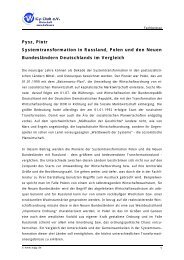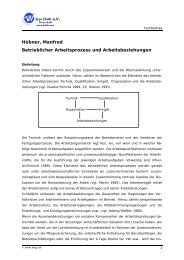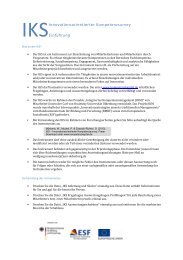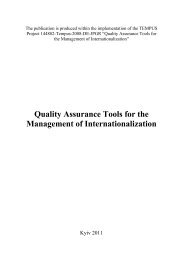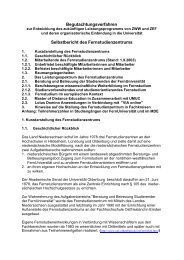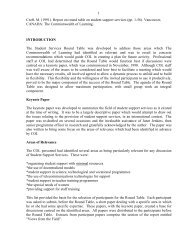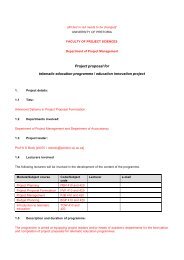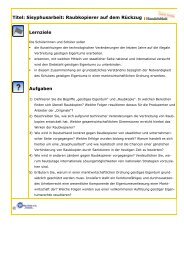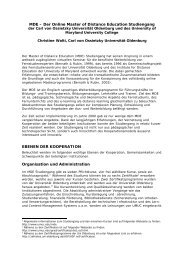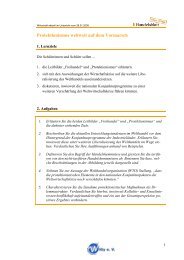Assessing the Costs and Benefits of Telelearning: A Case Study ...
Assessing the Costs and Benefits of Telelearning: A Case Study ...
Assessing the Costs and Benefits of Telelearning: A Case Study ...
You also want an ePaper? Increase the reach of your titles
YUMPU automatically turns print PDFs into web optimized ePapers that Google loves.
Methodology<br />
The methodology developed for this study is based on Bates (1995) ACTIONS<br />
model for assessing <strong>the</strong> strengths <strong>and</strong> weaknesses <strong>of</strong> learning technologies:<br />
A Access: how accessible is a particular technology for learners? How<br />
flexible is it for a particular target group?<br />
C <strong>Costs</strong>: what is <strong>the</strong> cost structure <strong>of</strong> each technology? What is <strong>the</strong> unit<br />
cost per learner?<br />
T Teaching <strong>and</strong> learning: what kinds <strong>of</strong> learning are needed? What<br />
instructional approaches will best meet <strong>the</strong>se needs? What are <strong>the</strong> best<br />
technologies for supporting this teaching <strong>and</strong> learning?<br />
I Interactivity <strong>and</strong> user-friendliness: what kind <strong>of</strong> interaction does this<br />
technology enable? How easy is it to use?<br />
O Organizational issues: what are <strong>the</strong> organizational requirements, <strong>and</strong><br />
<strong>the</strong> barriers to be removed, before this technology can be used<br />
successfully? What changes in organization need to be made?<br />
N Novelty: how new is this technology?<br />
S Speed: how quickly can courses be mounted with this technology?<br />
How quickly can materials be changed? (Bates, 1995, pp. 1-2,<br />
emphasis added)<br />
As part <strong>of</strong> this project, Cukier (1997) reviewed existing cost-benefit<br />
methodologies which have been used to assess educational technologies <strong>and</strong> suggested an<br />
approach to be used for this NCE-<strong>Telelearning</strong> project. Based on this approach, <strong>the</strong><br />
following cost <strong>and</strong> benefit factors are examined:<br />
<strong>Costs</strong>. Cost measures assessed in this study include:<br />
• capital <strong>and</strong> recurrent costs,<br />
• production <strong>and</strong> delivery costs, <strong>and</strong><br />
• fixed <strong>and</strong> variable costs.<br />
Capital costs are <strong>the</strong> expenses associated with <strong>the</strong> purchase <strong>of</strong> equipment <strong>and</strong><br />
materials. Recurrent or operating costs are expenses that occur on a regular basis (e.g.<br />
yearly) in order to run a program. An example would be computer support costs involved<br />
in <strong>the</strong> delivery <strong>of</strong> a course. As <strong>the</strong>ir names suggest, production <strong>and</strong> delivery costs are <strong>the</strong><br />
costs associated with <strong>the</strong> development <strong>and</strong> delivery <strong>of</strong> a particular course/program. In<br />
traditional, face to face instruction, <strong>the</strong>se costs are usually combined as <strong>the</strong> instructor<br />
both prepares <strong>and</strong> delivers lectures. These costs are unlikely to change significantly from<br />
year to year. For distance education courses however, <strong>the</strong>se costs must be analyzed<br />
separately as <strong>the</strong>re can be large differences in <strong>the</strong>se costs from year to year. Generally,<br />
<strong>the</strong> initial production costs are high but <strong>the</strong>n tend to be quite low in subsequent years<br />
(when revisions are minimal). Delivery costs can, however, stay at <strong>the</strong> same level each<br />
year (or course <strong>of</strong>fering). Fixed costs are costs that do not change with output (<strong>the</strong><br />
number <strong>of</strong> students taking <strong>the</strong> course), while variable costs do. This distinction between<br />
fixed <strong>and</strong> variable costs is important when comparing technologies or in determining <strong>the</strong><br />
number <strong>of</strong> students necessary to justify <strong>the</strong> use <strong>of</strong> a particular technology as different<br />
technologies have different proportions <strong>of</strong> fixed to variable costs (see Bates, 1995 for<br />
fur<strong>the</strong>r explanation).<br />
6



